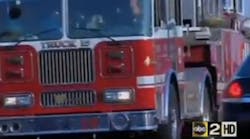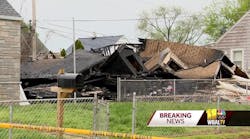The Baltimore City Fire Department plans to implement new social media guidelines after Chief James S. Clack said he found that firefighters and officers were "crossing the line" by posting inappropriate or sensitive information online.
The social media website Twitter has become a forum for griping about City Hall policies in 140 characters or fewer -- the maximum allowed in postings. The new policy comes after fire personnel have written a number of heated, politically charged barbs aimed at the department, Clack, Mayor Stephanie Rawlings-Blake and the City Council over a recent budgetary decision to close three fire companies in the city.
"If citizens/firefighters [are] hurt/die in areas of closings," Wilbur Smith, a nine-year department veteran with Truck 10, one of the companies set to close, wrote on Twitter last month, city politicians will "have to live knowing they could have prevented it."
The policy, which is still being drafted, would provide guidelines on appropriate social media postings. Some firefighters said they worry that the policy would be used as a political tool to stifle dissent among their ranks, and free-speech advocates have raised concerns about the right of employees to air opinions without fear of reprisal.
"It's happening more and more, cases are cropping up across the country, and it's troubling for people who care about free speech," said David L. Hudson, a scholar at the First Amendment Center at Vanderbilt University, who has written about public employees' social media rights.
"If the public employer deems that the online comments of a public employee are detrimental to the internal operations of the company, then sometimes employees are suspended, punished and disciplined."
Anthony Guglielmi, a Baltimore police spokesman, said his department is also creating a social media policy -- a draft version based on the guidelines of the International Association of Chiefs of Police is currently being reviewed by department lawyers. But he said the effort wasn't prompted by any problems.
"We haven't had any issues where [social media] has been abused, but we do need policies and procedures," Guglielmi said.
Smith, who drives emergency vehicles, said he doesn't understand "what the big deal is" if firefighters want to tweet, especially while they are not on duty. "I think the public has the right to know what's going on, rather than the smoke and mirrors," he said.
Firefighter Andrew Doyle, a 10-year veteran on Fire Boat 1, said the Fire Department should embrace social media rather than focus on censoring it. He has taken social media courses with the Federal Emergency Management Agency.
"We are one of the busiest fire departments in the nation, and sometimes we get overlooked by citizens and government," he said. "We just want to let them know we're here and we're keeping the city safe."
Clack says the intent of the Fire Department's new policy isn't to suppress critics and hopes the new policy will help prevent repercussions for inappropriate postings. Clack said the process first began about three months ago, and the new policy will be completed in the next few weeks.
"What we're attempting to do is define for members what is OK and what isn't," Clack said. "We're not going to be able to cover every scenario, but we want to provide some guidelines so people don't get themselves in trouble."
Clack would not provide examples of problematic postings or discuss individual fire personnel or their social media accounts. But said the department has noticed more Fire Department employees posting information on social media platforms, mainly on Twitter, that could be interpreted as official reports but are actually unofficial and often incorrect.
The department has also noted information posted about shootings and other violent incidents in the city that has the potential to harm police investigations or put working firefighters, paramedics or police officers in danger, Clack said.
"This is kind of an emerging issue in the fire service, and I guess in all kinds of professions," Clack said. "What do you do with this kind of instantaneous communication method that's out there? And how do you allow people to have their freedom of speech and engage in dialogue that's out there, but at the same time protect the department? That's what we're trying to balance."
Companies, governments and organizations have devised social media policies across the country in recent years, and employees have been reprimanded for sharing information related to their work online.
Last month, three members of the Bel Air Volunteer Fire Company in Harford County were suspended, a fourth was demoted and a fifth is facing termination after they complained on Facebook about not receiving a discount at a local restaurant. They joked about not responding to emergency calls there and possibly starting a fire in one of the restaurant's trash bins. The fire company is now reviewing its social media policies.
Last year, Pete Piringer, who had worked for decades as a public information officer for Fire and Emergency Medical Services in Washington, was transferred to another city agency after the Twitter account on which he wrote raised concerns among higher-ups, who believed sensitive information was being posted. District of Columbia Fire Chief Kenneth Ellerbe had told reporters he had decided Piringer's tweets needed to be "filtered," according to The Washington Post.
In Baltimore on June 20, Fire Battalion Chief Fred Ruff's popular Twitter feed, under the name @baltcityfire, largely fell silent. It had provided live, running updates about fire and police responses in the city and had amassed more than 2,200 followers, including many city journalists.
Just before updates on the feed slowed dramatically -- it wasn't deleted entirely -- Ruff, a 25-year veteran of the department, posted a burst of tweets saying the Fire Department had threatened to terminate him, and the Police Department had threatened to sue him, because of the account.
"Please let the politicians know that I am being possibly fired for telling the truth," he wrote.
Since then, he and city fire officials have largely kept mum on the issue.
Chief Kevin Cartwright, a fire spokesman, said that the incident had been "embellished to the 100th degree," that he had "no idea where the word termination came into play," and that Ruff was not being fired.
Guglielmi said police never threatened to sue Ruff, but that he called Cartwright to complain about improper tweets from Ruff's account that appeared official. "He used a generic logo, or some type of fire logo, that one could believe was an official account," Guglielmi said.
Ruff declined to comment for this article.
But many who had been following Ruff on Twitter responded to the situation with incredulity, criticizing the department for silencing an important source of information. Other firefighters on the site -- there are many who actively tweet about their work, anonymously in some cases -- pledged their support for Ruff.
Speculation about the demise of Ruff's feed has been rampant.
Fire Department members who spoke on the condition of anonymity because they weren't authorized to speak publicly and because they feared reprimand said they believe it was a purely political decision, made because Ruff -- like many other firefighters on the site -- had begun tweeting criticisms of the company closures.
The sources said fire and police officials became angry about several tweets by Ruff, including when he posted about an incident during the Sailabration events commemorating the War of 1812 during which a police officer accidentally tazed another officer.
Guglielmi said the Police Department mostly became concerned after Ruff tweeted that a juvenile was shot June 19 in West Baltimore, when the victim was in fact an adult. The 18-year-old later died.
"He put out unofficial and inaccurate information which led to phone calls from news agencies about whether a juvenile had been shot," Guglielmi said. "The police are the investigative agency of all shootings and homicides, and we prefer that we are the one that provides that information."
"They can tweet about union issues or about fire issues," he added. "It becomes unprofessional when you cross the lines into another agency's purview."
Public employees may have more latitude to discuss their government workplaces, but in many instances employers have legal standing to crack down on employees' online statements. A 2006 Supreme Court ruling, in Garcetti v. Ceballos, established that public employees are not protected by the First Amendment when speaking pursuant to their official duties, Hudson said.
Public employees can also face repercussions if they are writing online about their jobs while on duty, or writing things that could be considered "critical speech that causes some tangible harm or devastates morale, or puts the department in a terrible light," Hudson said.
As it drafts new social media guidelines, the city Fire Department is researching best practices around the country and bringing the fire unions into discussions about appropriate rules, Clack said. Once they are in place, the Fire Department will hold personnel accountable for infractions, he said.
"We will step in when we find out about them, and just tell the member or the person, 'This is not appropriate, and you need to stop,'" Clack said.
Baltimore firefighters union president Rick Hoffman said union attorneys will review a draft of the new policy but declined to comment further.
Some firefighters predicted that the policy would have little impact and would simply drive more fire personnel to start using social media anonymously.
Fire officials won't be able to ask them for their Twitter handles or passwords, under a law passed by the Maryland General Assembly this year that prohibits such social media requests from employers in the state.
A few of the most recent anonymous Twitter handles created to talk about fire in Baltimore are @BCFDREPORTER, @BCFDUnderground and @ghostof15hook. Truck 15 is one of the companies targeted for closure.
The brief description of the account on @ghostof15hook's homepage reads: "Killed 7/9/12 By a Mayor with no conscience, a Council with no morals, and a Chief with NO BACKBONE."
Inflammatory tweets
People identifying themselves as members of the Baltimore City Fire Department have called city and Fire Department officials a slew of insults in recent weeks on Twitter, mainly for their decision to close three of the city's fire companies. Many of the 140-character tweets can't be printed, but here's a sampling of some of the barbs:
@BCFDREPORTER on July 10: "@MayorSRB Cut fire companies due to budget crisis yet fire chief gets a guaranteed raise? Excellent business sense you have."
@ghostof15hook on July 10: "what ppl fail to realize is that @Baltfirechief has 0 ties to this city, these cuts are a resume boost for him, he wont be here in 10yrs"
@Engine714fever on July 3: "Has anyone ever been rescued out of a fire by a city mayor or council person? Just curious"
@WmRandomWard on June 30: "So Clack is postponing closures so the companies [can] handle calls from the storm. Guess we won't have anymore storms then...."
@ltpuddin on June 26: "Don't know if one person could possibly HATE their employer more than right now? I dare anyone to find one happy employee right now"
@BCFDWilbur on June 7: "@baltcityfire If citizens/firefighters r hurt/die in areas of closings.Politicians have to live knowing they could have prevented it."
Copyright 2012 - The Baltimore Sun
McClatchy-Tribune News Service






